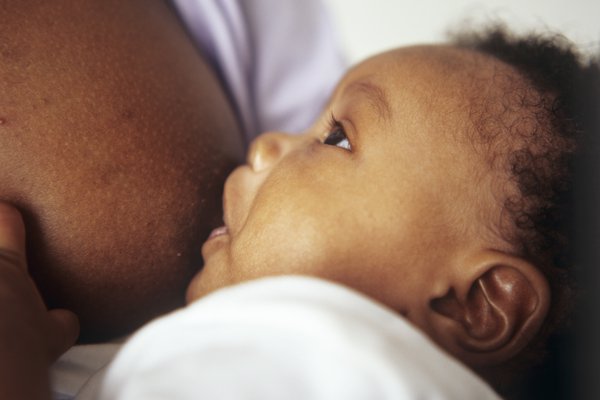Breastfeeding: is my baby getting enough milk?
When you first start breastfeeding, you may wonder if your baby is getting enough milk.
It may take a little while before you feel confident your baby is getting what they need.
Exclusive breastfeeding (breast milk only) is recommended for around the first 6 months of your baby's life. Introducing bottle feeds will reduce the amount of breast milk you produce.
Read Unicef's checklist How can I tell if breastfeeding is going well? for more guidance.
Signs your baby is well attached
- Your baby has a wide mouth and a large mouthful of breast.
- Your baby's chin is touching your breast, their lower lip is rolled down (you can't always see this) and their nose isn't squashed against your breast.
- You don't feel any pain in your breasts or nipples when your baby is feeding, although the first few sucks may feel strong.
- You can see more of the dark skin around your nipple (areola) above your baby's top lip than below their bottom lip.
Signs your baby is getting enough milk
- Your baby starts feeds with a few rapid sucks followed by long, rhythmic sucks and swallows with occasional pauses.
- You can hear and see your baby swallowing.
- Your baby's cheeks stay rounded, not hollow, during sucking.
- They seem calm and relaxed during feeds.
- Your baby comes off the breast on their own at the end of feeds.
- Their mouth looks moist after feeds.
- Your baby appears content and satisfied after most feeds.
- Your breasts feel softer after feeds.
- Your nipple looks more or less the same after feeds – not flattened, pinched or white.
- You may feel sleepy and relaxed after feeds.
Other signs your baby is feeding well
- Your baby gains weight steadily after the first 2 weeks – it's normal for babies to lose some of their birth weight in the first 2 weeks.
- They appear healthy and alert when they're awake.
- From the fourth day, they should do at least 2 soft, yellow poos the size of a £2 coin every day for the first few weeks.
- From day 5 onwards, wet nappies should start to become more frequent, with at least 6 heavy, wet nappies every 24 hours. In the first 48 hours, your baby is likely to have only 2 or 3 wet nappies.
It can be hard to tell if disposable nappies are wet. To get an idea, take an unused nappy and add 2 to 4 tablespoons of water. This will give you an idea of what to look and feel for.
Ways to boost your breast milk supply
- Ask your midwife, health visitor or breastfeeding specialist to watch your baby feeding. They can offer guidance and support to help you properly position and attach your baby to the breast.
- Avoid giving your baby bottles of formula for the first 6 months or a dummy until breastfeeding is well established.
- Feed your baby as often as they want and for as long as they want.
- Expressing some breast milk after feeds once breastfeeding is established will help build up your supply.
- Offer both breasts at each feed and alternate which breast you start with.
- Keep your baby close to you and hold them skin to skin. This will help you spot signs your baby is ready to feed early on, before they start crying.
Things that can affect your milk supply
- Poor attachment and positioning.
- Not feeding your baby often enough.
- Drinking alcohol and smoking while breastfeeding – these can both interfere with your milk production.
- Previous breast surgery, particularly if your nipples have been moved.
- Having to spend time away from your baby after the birth – for example, because they were premature.
- Illness in you or your baby.
- Giving your baby bottles of formula or a dummy before breastfeeding is well established.
- Using nipple shields – although this may be the only way to feed your baby with damaged nipples and is preferable to stopping feeding.
- Some medicines, including dopamine, ergotamine and pyridoxine. Read more about breastfeeding and medicines.
- Anxiety, stress or depression.
- Your baby having a tongue tie that restricts the movement of their tongue.
With skilled help, lots of these problems can be sorted out. If you have concerns about how much milk your baby is getting, it's important to ask for help early.
Speak to your midwife, health visitor or a breastfeeding specialist. They can also tell you where you can get further support.
Got a breastfeeding question?
For fast, friendly, trusted NHS advice anytime, day or night, talk to the Start4Life Breastfeeding Friend on Amazon Alexa, Facebook Messenger or Google Home.
Is my baby getting enough milk?
In this video, a health visitor talks about the signs your baby is getting enough milk.

